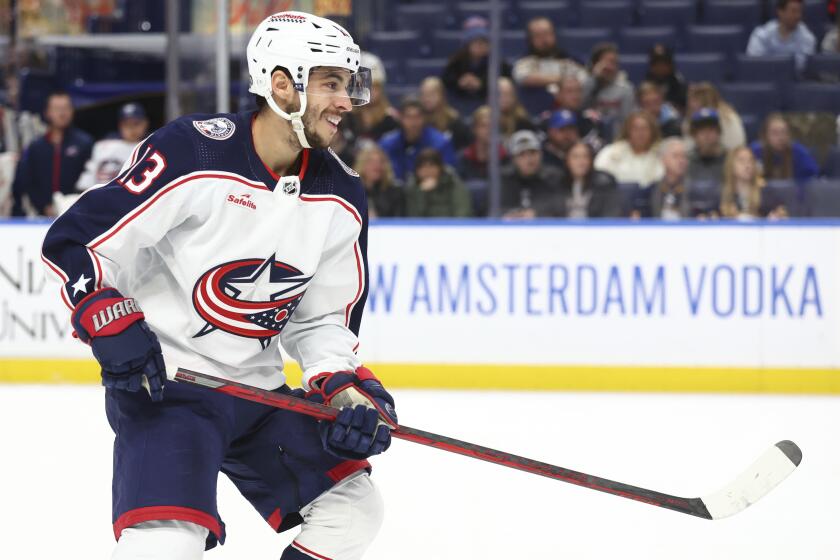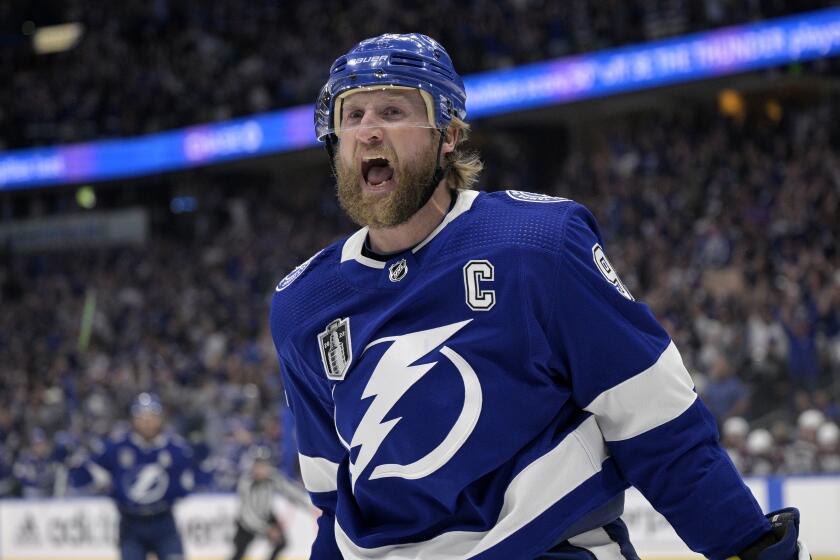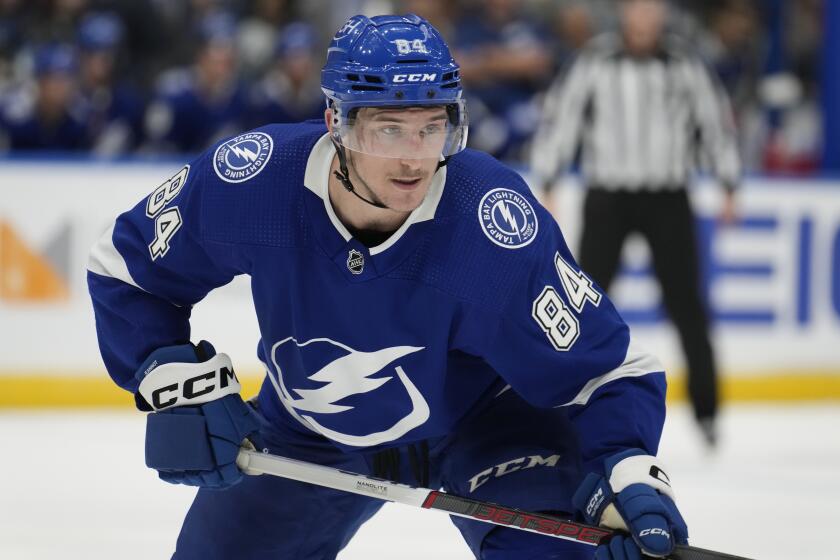Trying to Save Face
Life for Jordan Smith changed in an instant and without warning.
Smith, a second-round draft pick of the Mighty Ducks two years ago, was playing for the Portland Pirates in an American Hockey League game Feb. 24. A hard-nosed defenseman, Smith was protecting the Pirate net.
Then it happened.
A deflected puck on a routine shot slammed into the 20-year-old’s face. The injury was not routine, his left eye severely lacerated and the orbital bone shattered. And in that moment, a career was ended -- the sight in that eye gone forever.
There are those in hockey who say there is only one reason Smith will never play again: He did not wear a visor.
“The only reason there aren’t more [injuries like this] is just because of pure luck,” said Dr. Robert Devenyi, an ophthalmologist with Toronto Western Hospital who works with the Toronto Maple Leafs. “It’s a completely and totally avoidable event.”
The incident involved a minor league player, but a rash of eye injuries this season is pushing National Hockey League executives to strongly recommend that all of their players be required to wear visors as a means of protecting an important asset: their future.
Visors are mandatory for all junior hockey players. Colleges go one step further, requiring full-face shields.
It is different in the professional ranks, although that may be about to change. Brian Burke, a longtime NHL executive in his first year as general manager of the Ducks, had always sided with the players’ right to choose.
After visiting Smith in the hospital twice, that changed.
“I’m thinking now that, at the minimum, defensemen turning pro should be required to wear visors,” Burke said. The Ducks’ Ruslan “Salei got a real bad [injury to the eye] from a puck that was tipped, just like what happened to this kid. For sure, defensemen, and maybe all players.
“I don’t want to stand in a hospital room like that ever again,” he said.
The NHL and the majority of minor hockey leagues do not mandate visors, and doing so would require a collectively bargained agreement with the unions.
But the trend against visors may be shifting. There even has been talk of grandfathering in the protective visor, much as the leagues did with helmets not all that long ago.
The league does not keep a record of how many players wear visors, but an October study by the Hockey News said that 38% of the skaters in the NHL -- 244 of 640 -- wore one, a 3% increase over the 2003-04 season and roughly 20% up from 2001-02.
This, of course, does not count those who recently started wearing one, including the Ducks’ Joffrey Lupul and the Kings’ Craig Conroy.
And if the league had its way, everyone would wear one, said NHL deputy commissioner Bill Daly.
“Yes, a rule that would mandate the use of visors by players is one that the league supports,” he said. “We have had discussions with the players’ association about it, and while it was not something they were prepared to do for this season ... we’re hopeful that might be something we can accomplish by the start of next season.”
The NHL Players’ Assn. and the Professional Hockey Players Assn., which represents minor leaguers, have resisted such a measure for years, arguing that it would infringe on players’ rights.
Union spokesman Jonathan Weatherdon said the NHLPA discussed the issue with its player representatives and encouraged players to vote in an online survey after the season began. Results were not disclosed, but it is believed a decided majority do not want mandatory visors.
Yet the list of injuries grows.
* Toronto Maple Leaf captain Mats Sundin suffered a fractured orbital bone on opening night and was out a month.
* Detroit Red Wing captain Steve Yzerman ended up with a torn iris after being hit by a puck in the 2004 Stanley Cup playoffs.
* The Kings’ Pavol Demitra and the Ducks’ Salei have recently been knocked out of their lineups after being hit by pucks. Demitra was wearing a visor at the time. Salei didn’t but has put one on since.
“As bad as my injury is, it would have been a lot worse without a visor,” Demitra said.
Then there is the case involving Columbus Blue Jacket defenseman Bryan Berard. In 2000, Berard, then with Toronto, suffered a detached retina in his right eye when Marian Hossa’s stick inadvertently caught him in the face. A former rookie of the year, Berard needed seven surgeries to restore enough partial vision to allow him to play. Even today, his right eye is visibly smaller than his left.
But he hasn’t changed his mind about visors. “Professional athletes should be able to choose to wear the visors or not,” Berard said. “I know it’s been talked about grandfathering them in. But I think it’s a bit of a mistake because when guys feel protected, they get a little careless with their stick.
“Some guys like to feel the safety on their face and other guys don’t. It’s part of the game. When you grow up playing hockey on a pond, you’re not wearing a helmet. You kind of learn at a young age to watch your stick.
“The other part of it is pucks do fly around and guys get hit in the face with the puck. It’s a tough sport.”
While recognizing the hazards in their profession, many hockey players who go without a shield say visors can fog up because of perspiration, obscuring vision in a game in which the ability to see the puck is equal to success.
“When I first turned pro, I tried wearing a visor,” Duck center Todd Marchant said. “For whatever reason, I just didn’t like it. I tried it a couple of times since, but I never got comfortable with it.”
Detroit center Kris Draper put on a visor in October after his three children saw the large gash above his right eye, the result of a wayward puck. But Draper said it shouldn’t be mandatory: “The one thing I truly believe is it should be a choice.”
Berard, who now has 20/600 vision in his right eye and wears a contact lens to play, says he uses a visor only because doctors required it.
“For me, even after coming back from an eye injury, putting a visor on was a tough thing for me,” he said. “I really don’t have a choice, but it’s still a pain.”
Horrific incidents have led others to rethink visors. A career-threatening eye injury changed Demitra’s mind in 2001 while with the St. Louis Blues.
Now he swears by one.
A puck smashed into his face while he was playing for Slovakia in the Turin Olympics. He was left with a broken nose and bleeding behind his eye, causing him to miss six games with the Kings.
“I had the same thing happen to me five years ago. I didn’t wear one and I got hit with a stick in my eye,” Demitra said. “I decided then I was going to wear a visor. It was too important.”
Devenyi, a retinal surgeon with the Maple Leafs, operated on Berard and has dealt with eye injuries to several players, including Sundin. He has long advocated making visors mandatory but says his pleas have fallen on deaf ears.
“It’s a disgrace that they’re happening,” he said. “Players have shown quite eloquently that they won’t make the decision on their own. I truthfully don’t ask them anymore. It’s an insult and a waste of my time.”
Medical research supports him. There are fewer injuries when players wear a partial or full shield, according to Dr. Michael Stuart, chief medical officer for USA Hockey, who led a 2002 study of junior amateur players in the United States Hockey League.
Among the 282 players he studied, Stuart found that those without facial protection were 4.7 times more likely to incur an eye injury than those with partial protection. Players who wore a full shield or cage went unscathed.
Stuart, who is also the co-director of sports medicine at the Mayo Clinic in Rochester, Minn., knows there are many in hockey who will ignore the research no matter what.
“That freedom of choice outweighs the science,” Stuart said of some players’ mind-sets. “It’s their risk, they’re assuming. But I think it goes beyond that. We have a responsibility to look at the issue from the outside as well. We value the players’ opinion, but we also need to help them make this decision.”
Stuart’s three sons all play professional hockey. None wear facial protection.
Perhaps it’s because for many young players, the chance to take off the visor when they reach the pros is a rite of passage.
“I don’t know why,” said Corey Perry, a rookie with the Ducks this season. “I took it right off when I could and thought it was the coolest thing ever.”
It took a puck off his eye and some stitches to change Perry’s mind.
Berard accepts that the piece of high-impact polycarbonate plastic has saved many players from debilitating injuries. However, if the NHL is set on making visors mandatory, he said the league might be in for a fight with the players.
“Obviously our union would have to vote,” Berard said. “I’m sure the owners would want a say as well. It’s tough to say. But when you haven’t worn a visor, it’s a tough thing to get used to.”
Times staff writers Helene Elliott and Chris Foster contributed to this report.
More to Read
Go beyond the scoreboard
Get the latest on L.A.'s teams in the daily Sports Report newsletter.
You may occasionally receive promotional content from the Los Angeles Times.




